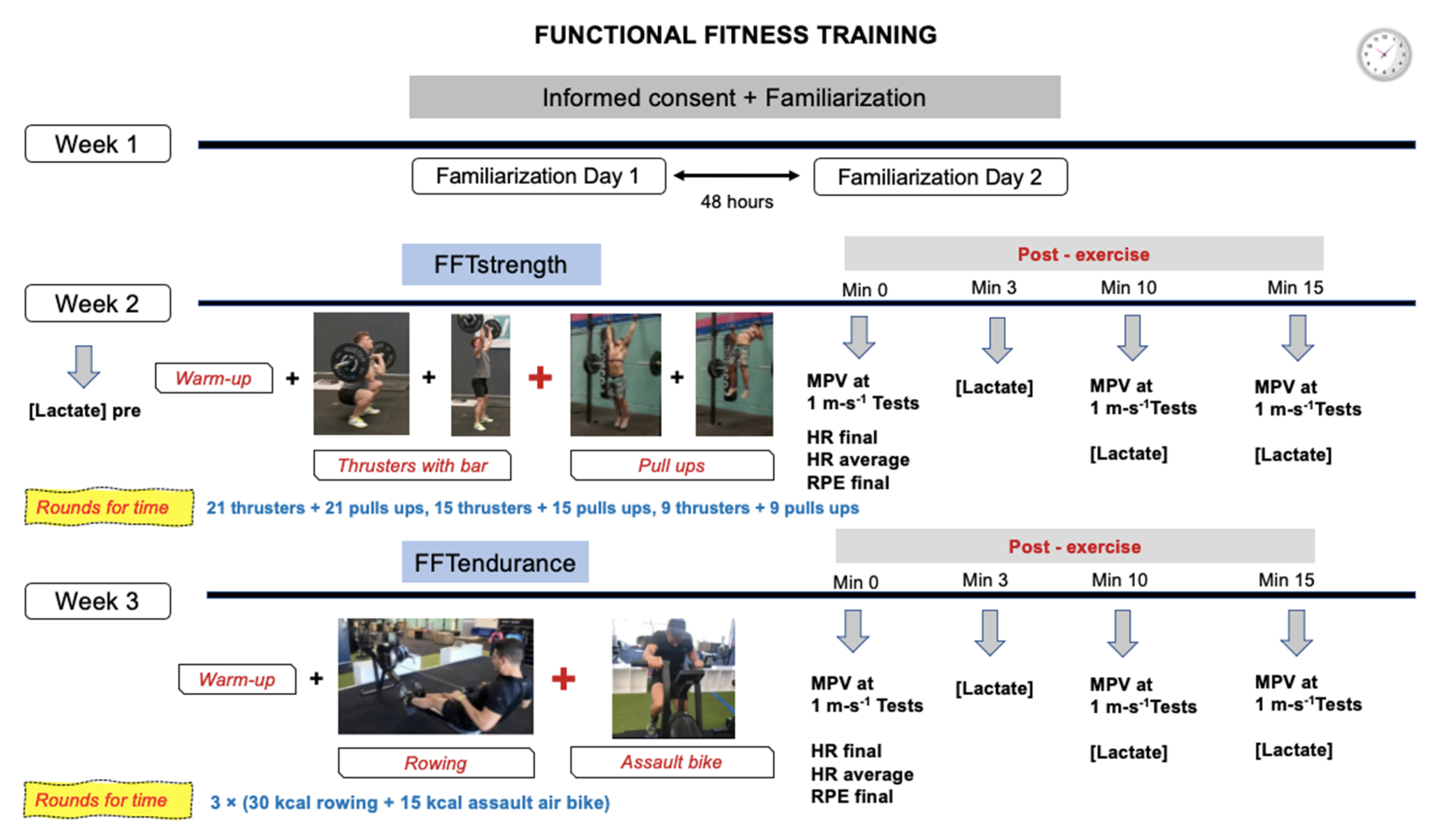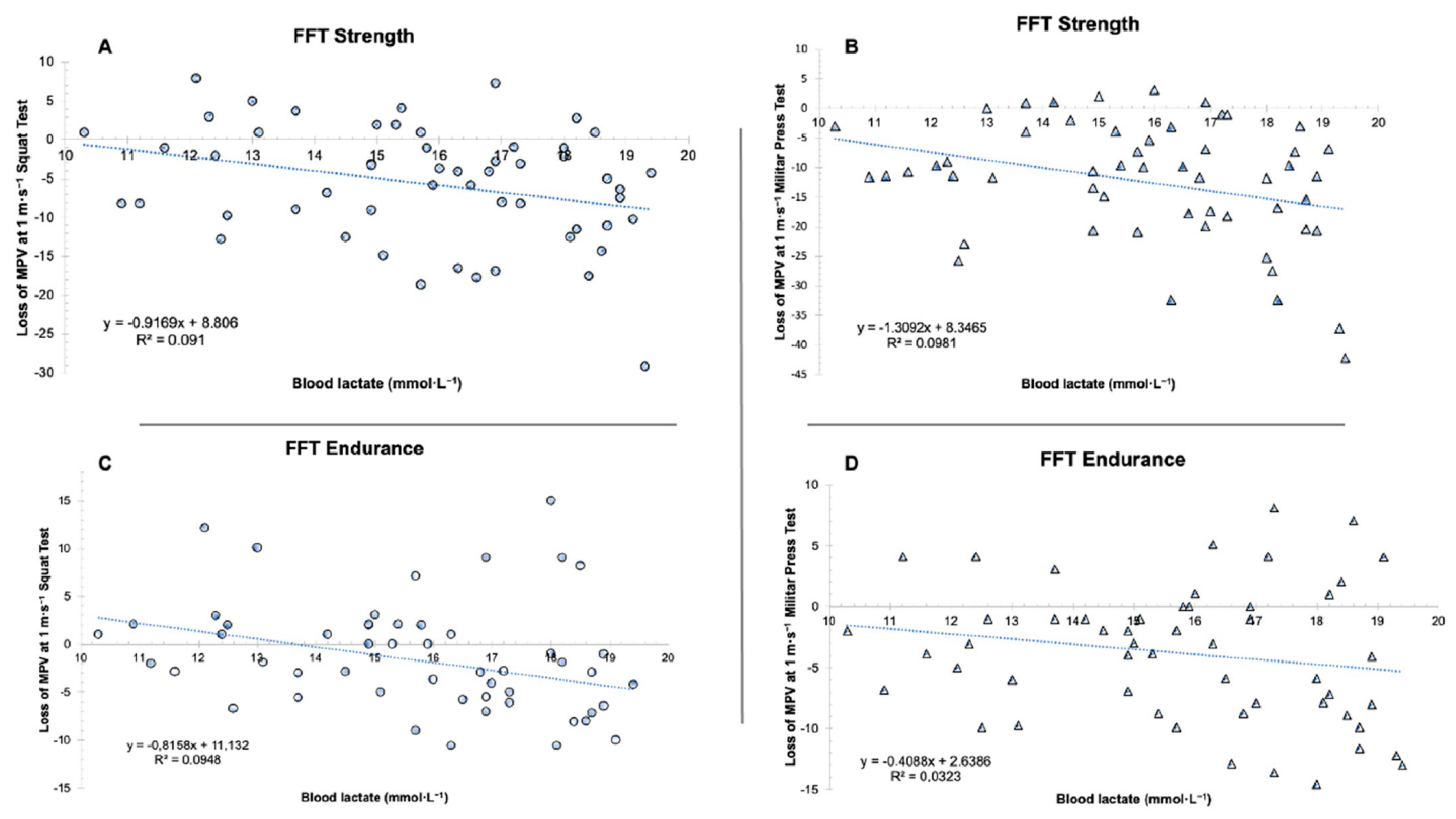Physiological Responses at 15 Minutes of Recovery after a Session of Functional Fitness Training in Well-Trained Athletes
Abstract
:1. Introduction
2. Materials and Methods
2.1. Study Design
2.2. Participants
2.3. Functional Fitness Training
2.4. Mechanical Measurements of Fatigue
2.5. Blood Lactate Concentrations
2.6. Ratings of Perceived Exertion
2.7. Heart Rate
2.8. Statistical Analysis
3. Results
4. Discussion
5. Conclusions
Author Contributions
Funding
Institutional Review Board Statement
Informed Consent Statement
Acknowledgments
Conflicts of Interest
References
- Heinrich, K.M.; Patel, P.M.; O’Neal, J.L.; Heinrich, B.S. High-intensity compared to moderate-intensity training for exercise initiation, enjoyment, adherence, and intentions: An intervention study. BMC Public Health 2014, 14, 789. [Google Scholar] [CrossRef] [PubMed] [Green Version]
- García-Fernández, P.; Cimadevilla, E.; Guodemar-Pérez, J.; Cañuelo-Márquez, A.M.; Heredia-Elvar, J.R.; Fernández-Rodríguez, T.; Lozano-Estevan, M.d.C.; Hervás-Pérez, J.P.; Sánchez-Calabuig, M.A.; Garnacho-Castaño, M.V.; et al. Muscle Recovery after a Single Bout of Functional Fitness Training. Int. J. Environ. Res. Public Health 2021, 18, 6634. [Google Scholar] [CrossRef] [PubMed]
- Silva-Grigoletto, M.E.D.; Heredia-Elvar, J.R.; Oliveira, L.A.D. “Cross” modalities: Are the AMRAP, RFT and EMOM models applicable to health? Rev. Bras. Cineantropom. Desempenho Hum. 2020, 22, e75400. [Google Scholar] [CrossRef]
- Hernández-Lougedo, J.; Cimadevilla-Pola, E.; Fernández- Rodríguez, T.; Guodemar-Pérez, J.; Otero-Campos, A.; del Carmen Lozano-Estevan, M.; Cañuelo-Márquez, A.M.; de Jesús-Franco, F.; Garnacho-Castaño, M.V.; García-Fernández, P.; et al. Effects of Introducing Rest Intervals in Functional Fitness Training. Appl. Sci. 2021, 11, 9731. [Google Scholar] [CrossRef]
- Feito, Y.; Heinrich, K.M.; Butcher, S.J.; Poston, W.S.C. High-Intensity Functional Training (FFT): Definition and Research Implications for Improved Fitness. Sports 2018, 6, 76. [Google Scholar] [CrossRef] [Green Version]
- Claudino, J.G.; Gabbett, T.J.; Bourgeois, F.; Souza, H.S.; Miranda, R.C.; Mezêncio, B.; Soncin, R.; Cardoso Filho, C.A.; Bottaro, M.; Hernández, A.J.; et al. CrossFitCrossFit Overview: Systematic Review and Meta-analysis. Sports Med. Open 2018, 4, 11. [Google Scholar] [CrossRef]
- Fernández-Fernández, J.; Sabio-Solana, R.; Moya, D.; Sarabia, J.M.; Moya, M. Acute physiological responses during Crossfit® workouts. Eur. J. Hum. Mov. 2015, 35, 114–124. [Google Scholar]
- Maté-Muñoz, J.L.; Lougedo, J.H.; Barba, M.; García-Fernández, P.; Garnacho-Castaño, M.V.; Domínguez, R. Muscular fatigue inresponse to different modalities of CrossFit sessions. PLoS ONE 2017, 12, e0181855. [Google Scholar]
- Maté-Muñoz, J.L.; Lougedo, J.H.; Barba, M.; Cañuelo-Márquez, A.M.; Guodemar-Pérez, J.; García-Fernández, P.; Lozano-Estevan, M.C.; Alonso-Melero, R.; Sánchez-Calabuig, M.A.; Ruiz-López, M.; et al. Cardiometabolic and Muscular Fatigue Responses toDifferent Crossfit® Workouts. J. Sports Sci. Med. 2018, 20, 668–679. [Google Scholar]
- Forte, L.D.M.; Freire, Y.G.C.; Junior, J.S.S.; Melo, D.A.; Meireles, C.L.S. Physiological responses after two different CrossFit workouts. Biol. Sport 2022, 39, 231–236. [Google Scholar] [CrossRef]
- Meyer, M.; Sundaram, S.; Schafhalter-Zoppoth, I. Exertional and CrossFit-Induced Rhabdomyolysis. Clin. J. Sport Med. 2021, 31, e290–e292. [Google Scholar] [CrossRef] [PubMed]
- Adhikari, P.; Hari, A.; Morel, L.; Bueno, Y. Exertional Rhabdomyolysis After CrossFit Exercise. Cureus 2021, 13, e12630. [Google Scholar] [CrossRef] [PubMed]
- Lawrensia, S.; Henrina, J.; Cahyadi, A. CrossFit-Induced Rhabdomyolysis in a Young Healthy Indonesian Male. Cureus 2021, 3, e14723. [Google Scholar] [CrossRef] [PubMed]
- Timon, R.; Olcina, G.; Camacho-Cardeñosa, M.; Camacho-Cardeñosa, A.; Martínez-Guardado, I.; Marcos-Serrano, M. 48-hour recovery of biochemical parameters and physical performance after two modalities of CrossFit workouts. Biol. Sport 2019, 36, 283–289. [Google Scholar] [CrossRef]
- Tibana, R.A.; De Almeida, L.M.; Frade de Sousa, N.M.; Nascimento Dda, C.; Neto, I.V.; De Almeida, J.A.; De Souza, V.C.; Lopes Mde, F.; Nobrega Ode, T.; Vieira, D.C.; et al. Two Consecutive Days of CrossfitCrossFit Training Affects Pro and Anti- inflammatory Cytokines and Osteoprotegerin without Impairments in Muscle Power. Front. Physiol. 2016, 7, 260. [Google Scholar] [CrossRef]
- Weisenthal, B.M.; Beck, C.A.; Maloney, M.D.; De Haven, K.E.; Giordano, B.D. Injury rate and patterns among CrossFit athletes. Orthop. J. Sports Med. 2014, 2, 2325967114531177. [Google Scholar] [CrossRef]
- Sánchez-Medina, L.; González-Badillo, J.J. Velocity loss as an indicator of neuromuscular fatigue during resistance training. Med. Sci. Sports Exerc. 2011, 43, 1725–1734. [Google Scholar] [CrossRef]
- Pallarés, J.G.; López-Samanes, A.; Fernández-Elías, V.E.; Aguado-Jiménez, R.; Ortega, J.F.; Gómez, C.; Ventura, R.; Segura, J.; Mora-Rodríguez, R. Pseudoephedrine and circadian rhythm interaction on neuromuscular performance. Scand. J. Med. Sci. Sport 2015, 25, e603–e612. [Google Scholar] [CrossRef]
- Association, W.M. World Medical Association Declaration of Helsinki: Ethical principles for medical research involving human subjects. JAMA 2013, 310, 2191–2194. [Google Scholar]
- Pérez-Castilla, A.; Piepoli, A.; Delgado-García, G.; Garrido-Blanca, G.; García-Ramos, A. Reliability and Concurrent Validity of Seven Commercially Available Devices for the Assessment of Movement Velocity at Different Intensities During the Bench Press. J. Strength Cond. Res. 2019, 33, 1258–1265. [Google Scholar] [CrossRef]
- McNaughton, L.R.; Thompson, D.; Philips, G.; Backx, K.; Crickmore, L. A comparison of the Lactate Pro, Accusport, Analox GM7 and Kodak Ektachem lactate analysers in normal, hot and humid conditions. Int. J. Sports Med. 2002, 23, 130–135. [Google Scholar] [CrossRef] [PubMed]
- McLean, S.R.; Norris, S.R.; Smith, D.J. Comparison of the Lactate Pro and the YSI 1500 Sport Blood Lactate Analyzers. Int. J. Appl. Sports Sci. 2004, 16, 22–30. [Google Scholar]
- Tibana, R.A.; De Sousa, N.M.F.; Cunha, G.V.; Prestes, J.; Fett, C.; Gabbett, T.J.; Voltarelli, F.A. Validity of session rating perceived exertion method for quantifying internal training load during high-intensity functional training. Sports 2018, 6, 68. [Google Scholar] [CrossRef] [PubMed] [Green Version]
- Field, A. Discovering Statistics Using IBM SPSS Statistics, 4th ed.; Sage: London, UK, 2013; pp. 473–474. [Google Scholar]
- Kliszczewicz, B.; Snarr, R.L.; Esco, M.R. Metabolic and Cardiovascular Response to the CrossFit Workout “Cindy”. J. Sport Hum. Perform. 2014, 2, 1–9. [Google Scholar]
- McCully, K.K.; Authier, B.; Olive, J.; Clark, B.J. Muscle Fatigue: The role of metabolism. Can. J. Appl. Physiol. 2002, 27, 70–82. [Google Scholar] [CrossRef]
- Smilios, I.; Hakkinen, K.; Tokmakidis, S.P. Power Output and Electromyographic Activity during and after a Moderate Load Muscular Endurance Session. J. Strength Cond. Res. 2010, 24, 2122–2131. [Google Scholar] [CrossRef]
- Finsterer, J. Biomarkers of peripheral muscle fatigue during exercise. BMC Musculoskelet. Disord. 2012, 13, 218. [Google Scholar] [CrossRef] [Green Version]
- González Badillo, J.J.; Yáñez García, J.M.; Mora Custodio, R.; Rodríguez-Rosell, D. Velocity loss as a variable for monitoring resistance exercise. Int. J. Sports Med. 2017, 38, 217–225. [Google Scholar] [CrossRef]
- Rodríguez-Rosell, D.; Yáñez-García, J.M.; Sánchez-Medina, L.; Mora-Custodio, R.; González-Badillo, J.J. Relationship Between Velocity Loss and Repetitions in Reserve in the Bench Press and Back Squat Exercises. J. Strength Cond. Res. 2020, 34, 2537–2547. [Google Scholar] [CrossRef]
- Robergs, R.A.; Ghiasvand, F.; Parker, D. Biochemistry of exercise-induced metabolic acidosis. Am. J. Physiol.-Regul. Integr. Comp. Physiol. 2004, 287, R502–R516. [Google Scholar] [CrossRef]
- Bigland-Ritchie, B.; Woods, J.J. Changes in muscle contractile properties and neural control during human muscular fatigue. Muscle Nerve 1984, 7, 691–699. [Google Scholar] [CrossRef] [PubMed]
- Enoka, R.M.; Stuart, D.G. Neurobiology of muscle fatigue. J. Appl. Physiol. 1992, 72, 1631–1648. [Google Scholar] [CrossRef] [PubMed]
- Allen, D.G.; Lamb, G.D.; Westerblad, H. Skeletal muscle fatigue: Cellular mechanisms. Physiol. Rev. 2008, 88, 287–332. [Google Scholar] [CrossRef] [Green Version]
- Westerblad, H.; Allen, D.G.; Lännergren, J. Muscle fatigue: Lactic acid or inorganic phosphate the major cause? News Physiol. Sci. 2002, 17, 17–21. [Google Scholar] [CrossRef] [PubMed]
- Steele, D.S.; Duke, A.M. Metabolic factors contributing to altered Ca2+ regulation in skeletal muscle fatigue. Acta Physiol. Scand. 2003, 179, 39–48. [Google Scholar] [CrossRef] [PubMed] [Green Version]
- Tomlin, D.L.; Wenger, H.A. The Relationship between Aerobic Fitness and Recovery from High Intensity Intermittent Exercise. Sports Med. 2001, 31, 1–11. [Google Scholar] [CrossRef]




| Variable | (M ± SD) |
|---|---|
| Time FFTstrength (s) | 291 ± 110 |
| Time FFTendurance (s) | 496 ± 62 |
| MVP at 1 m·s−1 Squat Test Load (kg) | 55.39 ± 10.51 |
| MVP at 1 m·s−1 Military Press Test Load (kg) | 34.22 ± 7.46 |
| Variable | FFT Group | Pre-Exercise (M ± SD, 95% CI) | Post-Exercise 0 min (M ± SD, 95% CI) | Post-Exercise 10 min (M ± SD, 95% CI) | Post-Exercise 15 min (M ± SD, 95% CI) | p Time ηp2 SP | p Group ηp2 SP | p Time × Group ηp2 SP |
| MVP at 1 m·s−1 Squat Test (m·s−1) | Strength | 1.01 ± 0.04 & (0.99–1.03) | 0.92 ± 0.09 £ † (0.88–0.96) | 0.96 ± 0.08 £ (0.93–0.99) | 0.97 ± 0.07 £ (0.95–1.00) | 0.001 * 0.356 0.964 | 0.002 * 0.426 0.917 | 0.008 * 0.206 0.849 |
| Endurance | 1.01 ± 0.03 (0.99–1.03) | 0.97 ± 0.07 # (0.93–1.01) | 1.00 ± 0.06 (0.97–1.03) | 1.01 ± 0.04 (0.98–1.04) | ||||
| MVP at 1 m·s−1 Military Press Test (m·s−1) | Strength | 1.00 ± 0.04 † (0.99–1.02) | 0.82 ± 0.1 £ † (0.78–0.86) | 0.89 ± 0.07 £ (0.87–0.92) | 0.93 ± 0.08 £ (0.90–0.96) | <0.001 * 0.613 1.000 | <0.001 * 0.721 1.000 | <0.001 * 0.456 1.000 |
| Endurance | 1.00 ± 0.02 & (0.99–1.02) | 0.94 ± 0.06 (0.90–0.98) | 0.96 ± 0.04 (0.94–0.99) | 0.98 ± 0.03 $ (0.95–1.01) | ||||
| Variable | FFT group | Pre-exercise (M ± SD, 95% CI) | Post-exercise 3 min (M ± SD, 95% CI) | Post-exercise 10 min (M ± SD, 95% CI) | Post-exercise 15 min (M ± SD, 95% CI) | p Time ηp2 SP | p Group ηp2 SP | p Time × Group ηp2 SP |
| Blood lactate (mmol·L−1) | Strength | 1.68 ± 0.31 † (1.55–1.82) | 17.85 ± 1.28 £ † (17.15–18.55) | 15.82 ± 2.00 £ † (14.92–16.72) | 13.76 ± 2.05 £ (12.86–14.65) | <0.001 * 0.982 1.000 | <0.001 * 0.623 0.999 | 0.008 * 0.241 0.829 |
| Endurance | 1.57 ± 0.24 † (1.44–1.71) | 16.68 ± 1.63 † (15.98–17.38) | 14.77 ± 1.74 † (13.87–15.67) | 12.55 ± 1.65 (11.66–13.44) |
| Variable | FFT | Post 0 min–Pre | Post 10 min–Pre | Post 15 min–Pre |
| % Loss of MVP at 1 m·s−1 Squat Test (%) | Strength | −8.91 | −4.95 | −3.96 |
| Endurance | −3.96 | −1 | 0 | |
| % Loss of MVP at 1 m·s−1 Military Press Test (%) | Strength | −18 | −11 | −7 |
| Endurance | −6 | −4 | −2 | |
| Post 10 min–Post 3 min | Post 15 min–Post 3 min | Post 15 min–Post 10 min | ||
| Blood lactate(%) | Strength | −11.37 | −22.91 | −13.02 |
| Endurance | −11.45 | −24.76 | −15.03 |
Publisher’s Note: MDPI stays neutral with regard to jurisdictional claims in published maps and institutional affiliations. |
© 2022 by the authors. Licensee MDPI, Basel, Switzerland. This article is an open access article distributed under the terms and conditions of the Creative Commons Attribution (CC BY) license (https://creativecommons.org/licenses/by/4.0/).
Share and Cite
Maté-Muñoz, J.L.; Budurin, M.; González-Lozano, S.; Heredia-Elvar, J.R.; Cañuelo-Márquez, A.M.; Barba-Ruiz, M.; Muriarte, D.; Garnacho-Castaño, M.V.; Hernández-Lougedo, J.; García-Fernández, P. Physiological Responses at 15 Minutes of Recovery after a Session of Functional Fitness Training in Well-Trained Athletes. Int. J. Environ. Res. Public Health 2022, 19, 8864. https://doi.org/10.3390/ijerph19148864
Maté-Muñoz JL, Budurin M, González-Lozano S, Heredia-Elvar JR, Cañuelo-Márquez AM, Barba-Ruiz M, Muriarte D, Garnacho-Castaño MV, Hernández-Lougedo J, García-Fernández P. Physiological Responses at 15 Minutes of Recovery after a Session of Functional Fitness Training in Well-Trained Athletes. International Journal of Environmental Research and Public Health. 2022; 19(14):8864. https://doi.org/10.3390/ijerph19148864
Chicago/Turabian StyleMaté-Muñoz, José Luis, Mihai Budurin, Salvador González-Lozano, Juan Ramón Heredia-Elvar, Ana María Cañuelo-Márquez, Manuel Barba-Ruiz, Diego Muriarte, Manuel Vicente Garnacho-Castaño, Juan Hernández-Lougedo, and Pablo García-Fernández. 2022. "Physiological Responses at 15 Minutes of Recovery after a Session of Functional Fitness Training in Well-Trained Athletes" International Journal of Environmental Research and Public Health 19, no. 14: 8864. https://doi.org/10.3390/ijerph19148864
APA StyleMaté-Muñoz, J. L., Budurin, M., González-Lozano, S., Heredia-Elvar, J. R., Cañuelo-Márquez, A. M., Barba-Ruiz, M., Muriarte, D., Garnacho-Castaño, M. V., Hernández-Lougedo, J., & García-Fernández, P. (2022). Physiological Responses at 15 Minutes of Recovery after a Session of Functional Fitness Training in Well-Trained Athletes. International Journal of Environmental Research and Public Health, 19(14), 8864. https://doi.org/10.3390/ijerph19148864








